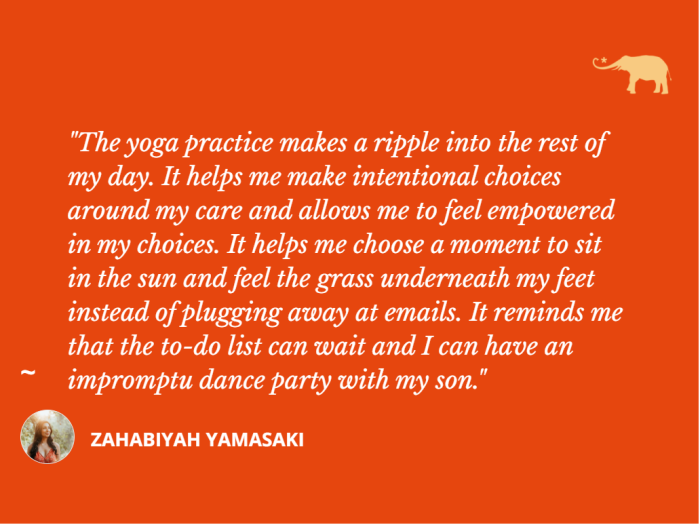View this post on Instagram
“A healthy nervous system is not always calm. It is flexible and resilient.” ~ Jessica Maguire
These days, I don’t know anyone who is not waiting for the next shoe to drop, the next sniffle to arise, the next crisis to make its way.
It can feel impossible to not have our armor up as we prepare our minds and bodies for the next storm.
I remember recently being on the phone with health insurance for two hours and I could just feel the irritability brewing and the bandwidth weaning. I couldn’t find the form I needed. The person on the other line was losing her patience with me. My son was out of school due to a COVID-19 exposure and was yelling for me in the background. I was on a writing deadline. Enter: trauma-informed yoga.
I want to make it clear that no yoga posture, asana, affirmation, or shape can take away the collective trauma and grief we have experienced these past two years. We need systemic change, support, resources, a village…the list is endless in terms of the community care folks are so desperately in need of. What the practice may do is to help to soften the edges, give us the gift of being gentle and compassionate with ourselves, and provide a space to show up in all of our humanness.
On some of my hardest days, I repeat an affirmation from Dr. Susana Munoz: “I am not behind or unproductive. I am doing as much as my mind and body are allowing me to do under perpetual stress and fatigue.” It is a reminder that stays with me both on and off my mat.
Vinyasa: To place in a special way.
Below is an excerpt from my new book: Trauma-Informed Yoga for Survivors of Sexual Assault: Practices for Healing and Teaching with Compassion.
In Sanskrit, the term vinyasa means to place in a special way. I remember the first time I really internalized this translation. I remember the joy and space it brought to my practice and the way it transformed the agency of my choices.
Those sacred moments in Tadasana (Mountain Pose) where I felt the power of standing in my own truth. Or moving through repeated sun salutations with no other focus than connecting the power of my movement with my breath. Or those times in Virabhadrasana II (Warrior II) or Utthita Tadasana (Star Pose) where I could notice the palpable feeling of taking up space, amid all the ways trauma makes it easy to stay small.
And finally, the restorative moments in Balasana (Child’s Pose) where I spent the entire practice and reminded myself that I was worthy of rest.
I like to think of my practice as a bridge to my life. The tools I have gained within the four corners of my yoga mat have empowered me to make intentional choices as I navigate both the messiness and the beauty of the healing journey.
The practice provides a space for me to protect my energy and my peace and to embrace pockets of relief in joy—no matter how fleeting. My practice has shown me what it means to be a steady and safe anchor amid the intense crashing of the waves. The stormy seasons. The trying moments that life inevitably presents. The practice is always there as a reminder. An integration. A renegotiation. An option to choose another way. A soft place to land. To ground. To feel peace even amid the resistance—even when it’s hard.
The practice provides a container for my needs and clarity around what those needs actually are. It offers a compassionate anchor and a place to be held. To release the perfectionism and the need to constantly do. The practice helps me honor my truth. To know, understand, and feel my capacities. To find my own embodied language.
It offers a way to be mindful of my reactions and of what deserves my energy. A place to get lost in the flow of the present. A journey to uncovering the messages behind the trauma imprints that reside inside. It offers a gentle yet powerful reminder of the parts of me that need my own love and my own attention. A place to be reminded that I am inherently whole. A way to return to me.
Craving safety in the stillness
Please know that you are not alone if you are navigating perpetual states of burnout and fatigue. I often find myself saying, “well after I get through this stressful week,” or “after I finish that project,” I will rest and feel better. When I got still enough, it revealed to me how unsustainable I have been moving for years—even before the pandemic. The pandemic revealed and brought to the surface how much our systems have been working in excess.
Our adrenals regulate the levels of cortisol in our bodies and adrenal fatigue can make even seemingly small tasks feel incredibly overwhelming. Dr. Ann Masten has coined the term “surge capacity,” which essentially is a collection of coping tools (both mental and physical) that humans draw on for short term survival in stressful situations. For many of us, the fumes we have been running on to keep pushing through this pandemic have run out and our surge capacity is depleted. You might find yourself saying that you are tired all of the time and this can mean so many different things. Your exhaustion is so very valid and so very real.
A colleague recently asked me how my work as a trauma-informed yoga instructor and educator has changed since the pandemic. What I reflected to him was that so many folks are showing up to these virtual classes completely exhausted and zapped of energy. I find that so much of the container I am cultivating these days is a place for folks to rest. I am finding that many survivors are craving stillness in a way that feels safe. That allows their nervous system to downregulate, restore, and recalibrate. That provides a space to support sensory self-care and a break from the overstimulation of the constant barrage of information we are consuming daily. That gives them a little more bandwidth and capacity for whatever the day may throw their way.
As I gaze around the tiny Zoom squares and witness folks in their own unique shape of rest, I can’t help but smile and soften. For me, there isn’t a greater gift than holding space for folks in this way and to remind them often that they are enough just as they are. That their productivity does not determine their worth. To affirm that of course they are exhausted and burnt out. That they are so unbelievably worthy of rest and that they don’t have to earn it.
Tenderness, compassion, community, intentionality, and rest are all integral components of the healing process. Intentionally choosing rest, space, and ease can be incredibly challenging for trauma survivors. Be gentle with yourself when it’s hard, pace yourself, and continue to take what you need. If possible, try and resist the urge to fill the space. When you have been accustomed to survival mode for so long, embodying this new way of being in the world may take time. Keep reminding yourself that you deserve to know what deep rest feels like.
An entry point and a soft place to land
Trauma-informed yoga supports survivors in activating their parasympathetic nervous system and creates more space for safety, rest, growth, and joy. It can help us expand our capacity for neuroplasticity and widen our window of tolerance to build more resilience and rest into our days.
When given these tools, folks can also access greater depths of inner capacity and resilience in navigating not only trauma and crisis but also the everyday challenges and stressors that life presents. It is one modality among many in my toolbox to support me with the softening and tending to my anxiety with the utmost love and care.
I began this article talking about my call with insurance and the irritability that has been creeping its way into my days. My daily practice provides a buffer and a resource. A little more space and a little more ease. A little more patience and a little more grace. Because who doesn’t need more of that these days?
And so often, the practice makes a ripple into the rest of my day. It helps me make intentional choices around my care and allows me to feel empowered in my choices. It helps me choose a moment to sit in the sun and feel the grass underneath my feet instead of plugging away at emails. It reminds me that the to-do list can wait and I can have an impromptu dance party with my son. It helps me practice forgiveness with myself, release the perfectionism and the overworking, and choose to nap in the middle of the day. It helps me say no and protect my energy. It reminds me that I am worthy of mental health days. It gives my nervous system the boost it needs to navigate the systems that unfortunately are not set up for us to thrive.
Reclaiming our bodies and honoring rest is a daily practice and not a linear one. You are not alone in whatever storm you may be navigating today.
My book and deck cards are now available for ordering. Check out my website for more details on where to get your copy.


 Share on bsky
Share on bsky





Read 3 comments and reply